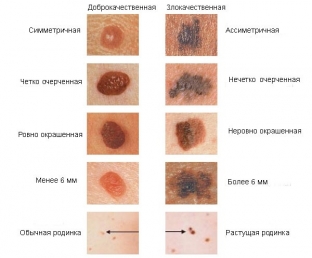The rate of skin cancer has quadrupled over the past forty years. This trend worries both doctors and patients. In this regard, Drs. Carl Thornfeldt and Mervin Patterson stress the need for patient education and maximum daily skin protection in preventing malignant melanoma.
Experts told what causes malignant melanoma, what skin formations may indicate the presence of this disease, and what means of protection against malignant melanoma each person should use.
Malignant melanoma and ultraviolet A rays
There is a link between malignant melanoma and nevi (moles), which are pigmented growths on the skin. Availability of 1 – 5 atypical or dysplastic nevi increases the risk of developing melanoma by 3.8 times. Having 6 or more atypical nevi increases the risk by 6.3 times, and 25 or more dysplastic or even common nevi increases the risk of developing malignant melanoma by 9.8 times.
Invisible ultraviolet B rays cause non-melanocytic basal cell and squamous cell skin cancer. Ultraviolet rays of spectrum A not only contribute to the appearance of wrinkles, but also suppress protective immunity, which consequently leads to the activation of malignant melanoma. Ultraviolet rays of both spectra cause DNA damage and cell mutation even before the appearance of redness or sunburn.
It is important to remember that tanned skin – it's damaged skin. There is no safe tan. Therefore, it is necessary to apply sunscreen on the skin in the summer, not only on sunny days, but always. Ultraviolet A rays penetrate clouds and windows and are reflected from concrete, asphalt, snow and even grass and affect the skin at any time of the year.
Sunbeds and malignant melanoma: sunburn or skin health
Sunbeds in the US are called "cancer in a jar" and "new nicotine" because the WHO recognized ultraviolet A and B rays as carcinogenic to tobacco.
A person in a tanning bed can receive four times the dose of ultraviolet A rays and double – spectrum B compared to the same time in the sun.
We don't feel ultraviolet A rays on the skin, but they contribute significantly to aging and skin cancer. Spectrum A ultraviolet rays suppress the function of surface cells (Langerhans cells), which "calculate" damaged cells and send leukocytes to destroy the damaged cells, usually before they turn from precancerous dysplastic to cancerous cells. Also, such rays damage the protective barrier of the skin.
8 criteria for diagnosing malignant melanoma
The following criteria help in the diagnosis of malignant melanoma (especially early stage melanoma, which is highly treatable) with an accuracy of approximately 90%.
- Any skin growths that are different in appearance and feel.
- The appearance of any neoplasms on the skin at the age of 25 years or more.
- The growth of the formation in breadth at the base.
- Bleeding from a bump or nodule on the skin.
- Change in sensation (itching, tenderness, redness, soreness) that lasts more than 2 weeks.
- The spread of pigmentation beyond the boundaries of the formation on the skin.
- Any change in skin lesions present from birth.
- You are concerned about any skin lesion because of the look or feel of it.
Diagnosis of malignant melanoma according to ABCDE criteria
Prevention of malignant melanoma: ways to protect
- Apply sunscreen
For best protection, apply sunscreen twice in the morning: the first – on clean, dry and chilled skin, and the second – 30 minutes after the first application (also 30 minutes before going outside). These are the recommendations of dermatologists.
- Healthy and properly functioning skin barrier. In the case of skin damage, such as burns or sunburn, after the redness has been eliminated, it is necessary to improve the synthesis of three groups of fats that are necessary for the proper functioning of the skin barrier: cholesterol, free fatty acids and ceramide. After that, it is necessary to accelerate the proliferation of epidermal cells. Chemical peels and microdermabrasion work well with this.
- Sun protection clothing, hats and goggles.
- Healthy foods, including anti-inflammatory foods, foods low in fat, sugar and starch, fruits and vegetables, oily fish, and sunscreen foods. Green teas, pomegranate, grape seeds and chocolate with 55% cocoa content (black) are also helpful.







Add a comment